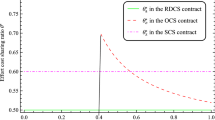Abstract
This paper develops a volume discount scheme to coordinate Vendor Managed Inventory (VMI) supply chains with multiple heterogeneous retailers, in which the supply chain is modelled as a Stackelberg game with price sensitive demand. The paper proposes a method to construct a volume discount price scheme and shows that, any volume discount can be represented as a piecewise constant function of demand. We provide the game formulations of VMI supply chains and develop algorithms to solve this type of game problems, including finding the optimal volume discount scheme. Through a numerical study comparing the results of applying a volume discount strategy with the profits from a single wholesale price strategy, we show that the volume discount pricing strategies can be used to improve profits for all participants in the VMI supply chain in comparison with single price strategies.
Similar content being viewed by others
References
Benton WC and Park S (1996). A classification of literature on determining the lot size under quantity discounts. European Journal of Operational Research 92 (2): 219–238.
Bernstein F, Chen F and Federgruen A (2006). Coordinating supply chains with simple pricing schemes: The role of vendor-managed inventories. Management Science 52 (10): 1483–1492.
Cai GS, Zhang Z and Zhang M (2009). Game theoretical perspectives on dual-channel supply chain competition with price discounts and pricing schemes. International Journal of Production Economics 117 (1): 80–96.
Chen FR, Federgruen A and Zheng YS (2001). Coordination mechanisms for a distribution system with one supplier and multiple retailers. Management Science 47 (5): 693–708.
Emmons H and Gilbert SM (1998). Note: The role of returns policies in pricing and inventory decisions for catalogue goods. Management Science 44 (2): 276–283.
Giannoccaro I and Pontrandolfo P (2004). Supply chain coordination by revenue sharing contracts. International Journal of Production Economics 89 (2): 131–139.
Goyal SK and Gupta YP (1989). Integrated inventory models: The buyer–vendor coordination. European Journal of Operational Research 41 (3): 261–269.
Kuo CW, Guo RS and Wu YF (2011). Optimal pricing strategies under co-existence of price-takers and bargainers in a supply chain. Journal of the Operational Research Society 63 (7): 865–882.
Lal R and Staelin R (1984). An approach for developing an optimal discount pricing policy. Management Science 30 (12): 1524–1539.
Munson CL and Rosenblatt MJ (1998). Theories and realities of quantity discounts: An exploratory study. Production and Operations Management 7 (4): 352–359.
Munson CL, Rosenblatt MJ and Rosenblatt Z (1999). The use and abuse of power in supply chains. Business Horizons 42 (1): 55–65.
Qin YY, Tang HW and Guo CH (2007). Channel coordination and volume discounts with price-sensitive demand. International Journal of Production Economics 105 (1): 43–53.
Rosenblatt MJ and Lee HL (1985). Improving profitability with quantity discounts under fixed demand. IIE Transactions 17 (4): 388–395.
Sarmah SP, Acharya D and Goyal SK (2006). Buyer vendor coordination models in supply chain management. European Journal of Operational Research 175 (1): 1–15.
Sinha S and Sarmah SP (2010a). Single-vendor multi-buyer discount pricing model: An evolutionary computation-based approach. International Journal of Operational Research 8 (1): 1–19.
Sinha S and Sarmah SP (2010b). Single-vendor multi-buyer discount pricing model under stochastic demand environment. Computers and Industrial Engineering 59 (4): 945–953.
Swami S and Shah J (2012). Channel coordination in green supply chain management. Journal of the Operational Research Society, advance online publication, 9 May; doi:10.1057/jors.2012.44.
Viswanathan S and Piplani R (2001). Coordinating supply chain inventories through common replenishment epochs. European Journal of Operational Research 129 (2): 277–286.
Viswanathan S and Wang QN (2003). Discount pricing decisions in distribution channels with price-sensitive demand. European Journal of Operational Research 149 (3): 571–587.
Wang Q (2002). Determination of suppliers’ optimal quantity discount schedules with heterogeneous buyers. Naval Research Logistics 49 (1): 46–59.
Wang Q and Wang R (2005). Quantity discount pricing policies for heterogeneous retailers with price sensitive demand. Naval Research Logistics 52 (7): 645–658.
Weng Z (1995). Channel coordination and quantity discounts. Management Science 41 (9): 1509–1522.
Yu Y, Liang L and Huang GQ (2006a). Leader-follower game in vendor-managed inventory system with limited production capacity considering wholesale and retail prices. International Journal of Logistics: Research and Applications 9 (4): 335–350.
Yu Y, Liang L, Xu KN and Wang ZQ (2006b). VMI integration considering pricing, production capacity and raw material procurement. Journal of University of Science and Technology of China 36 (7): 781–787 (in Chinese).
Yu Y, Chu F and Chen H (2009a). A stackelberg game and its improvement in a VMI system with a manufacturing vendor. European Journal of Operational Research 192 (3): 929–948.
Yu Y, Huang GQ and Liang L (2009b). Stackelberg game-theoretic model for optimizing advertising, pricing and inventory policies in vendor managed inventory (VMI) production supply chains. Computers and Industrial Engineering 57 (1): 368–382.
Zhou YW (2007). A comparison of different quantity discount pricing policies in a two-echelon channel with stochastic and asymmetric demand information. European Journal of Operational Research 181 (2): 686–703.
Acknowledgements
The authors would like to thank the editor and referees for their valuable comments and suggestions that have helped us greatly in improving the paper.
Author information
Authors and Affiliations
Corresponding author
Additional information
Correction
In an earlier version of this article the first author's name was spelt incorrectly. This has been corrected.
Rights and permissions
About this article
Cite this article
Braide, S., Cao, Z. & Zeng, X. Volume discount pricing strategy in the VMI supply chain with price sensitive demand. J Oper Res Soc 64, 833–847 (2013). https://doi.org/10.1057/jors.2012.85
Received:
Accepted:
Published:
Issue Date:
DOI: https://doi.org/10.1057/jors.2012.85




